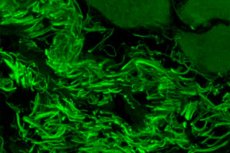How dry eye affects the ocular microbiome
Last reviewed: 07.06.2024

All iLive content is medically reviewed or fact checked to ensure as much factual accuracy as possible.
We have strict sourcing guidelines and only link to reputable media sites, academic research institutions and, whenever possible, medically peer reviewed studies. Note that the numbers in parentheses ([1], [2], etc.) are clickable links to these studies.
If you feel that any of our content is inaccurate, out-of-date, or otherwise questionable, please select it and press Ctrl + Enter.

We have all heard of the microbiome, which lives in the human gastrointestinal tract, but microbiomes also exist in other parts of the body, including skintitle="Human Skin Microbiome: Impact of Intrinsic and Extrinsic Factors on Skin Microbiota - PMC">Mouthtitle="Oral microbiome: Unveiling the fundamentals - PMC">Nosetitle="The Microbiome of the Nose—Friend or Foe? - PMC">Earstitle="Analysis of the Microbiome of the Ear Canal in Normal Individuals and Patients with Chronic Otitis Externa - PMC">And eyes.
Over the past few years, researchers have focused on studying the eye microbiome and its role in eye diseasestitle="Ocular surface microbiota: Ophthalmic infectious disease and probiotics - PMC">Including dry eye, a condition that affects up to 50% of the world's populationtitle="Prevalence of Dry Eye Symptoms and Associated Risk Factors among University Students in Poland - PMC">.
Now a new study recently presented at Discover BMB the annual meeting of the American Society for Biochemistry and Molecular Biology, reports how the ocular microbiomes of healthy eyes and people with dry eyes differ in microbial composition.
Researchers at Stephen F. Austin State University believe this discovery could help improve treatment not only for dry eye, but also for other eye conditions.
What is the microbiome of the eye?
The ocular microbiome is the community of bacteria and other microorganisms present on the conjunctiva and cornea.
The conjunctiva of the eye is a thin transparent membrane covering the white part of the eye, and the cornea is a transparent dome-shaped covering of the very front of the eye.
"Recent studies show that in dysbiosis in the gut microbiometitle="Gut Microbiota Dysbiosis: Triggers, Consequences, Diagnostic and Therapeutic Options - PMC">Pathogenic microbes and their metabolites are transported through the bloodstream and reach other areas of the human body, such as the eye," said Dr. Alexandra Martynova Van Clay, professor of biology at Stephen F. Austin State University and leader of the research team for this study. "Therefore, the microbes identified in the ocular microbiome may be similar to the gut microbiome."
In addition to dry eye, scientists are studying the impact of the ocular microbiome on other eye diseases such as age-related yellow spot degeneration (AMD), glaucoma, diabetic retinopathy and cataracts.
Acinetobacter predominates in the microbiome of dry eye syndrome
For this study, Dr. Martynova-Van Clay and her team collected eye samples from 30 volunteer participants using swabbing. They then performed 16S rRNA sequencingtitle="Performance and Application of 16S rRNA Gene Cycle Sequencing for Routine Identification of Bacteria in the Clinical Microbiology Laboratory - PMC">And bioinformatics analysistitle="Bioinformatics and Computational Biology | National Institute of General Medical Sciences">To find out what is included in the eye microbiome of people with dry eyes compared to healthy eyes.
In the analysis, the researchers found that Streptococcus and Pedobacter bacterial species were the dominant microbes in the ocular microbiomes of study participants with healthy eyes.
Researchers found that the microbiome of the eyes of participants with dry eye syndrome was dominated by Acinetobacter species of bacteria.
"It was surprising to learn that the eye microbiome in dry eye syndrome consists mainly of Acinetobacter species, but we found that other eye diseases, such as hypertension and high cholesterol, have other species closely related to each other. A better understanding of what causes dry eye syndrome is important to improve the diagnosis, treatment and prevention of this disease" said Dr. Alexandra Martynova-Van Clay.
"Understanding the causes of dry eye provides valuable information that can contribute to the development of new therapeutic approaches that lead to better outcomes for people suffering from this condition," she continued.
"The next steps will be to increase sample size and understand the signaling pathways associated with indicator species in dry eye syndrome. This could provide insight into the metabolites responsible for the disease," she added.
Studies confirming past discoveries
After reviewing the study, Dr. David Geffen, director of optometry and refractive services at the Gordon Schanzlin New Vision Institute in La Jolla, California, said he found it very interesting.
"If we can change the microbiome of the eye to help patients with dry eye syndrome, it will be a real breakthrough," Dr. Geffen continued. "Dry eye is a serious problem, and this new approach to it could prove to be the solution for millions of people suffering."
